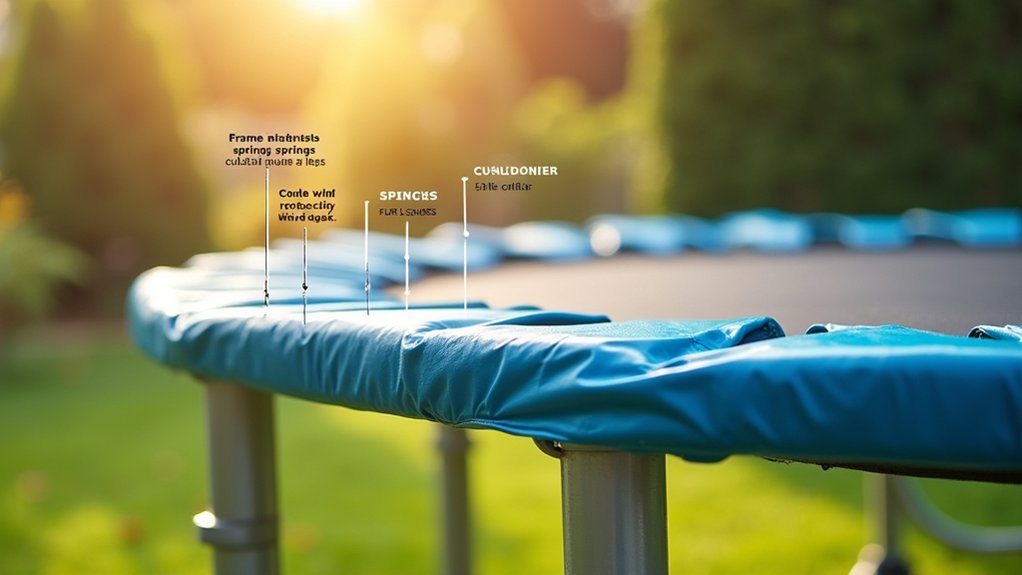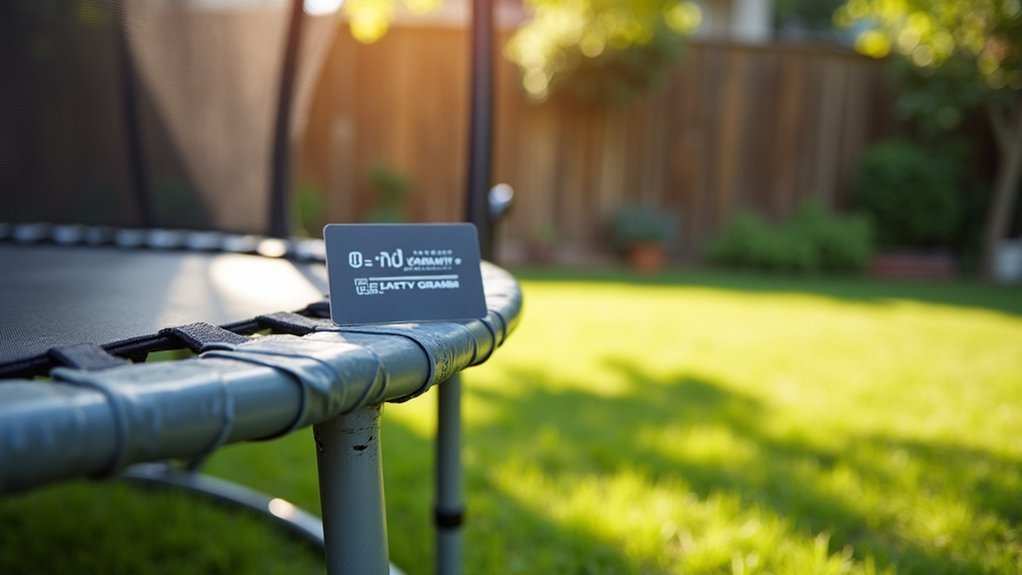Rebounder warranties typically cover manufacturing defects with varying protection periods by component—frames often get 3-10 years or lifetime coverage, while mats and springs receive 1-3 years. You’ll need to register your purchase, stay within weight limits (usually 102-136kg), and avoid unauthorized modifications to maintain validity. Commercial use warranties offer shorter coverage than residential ones. Understanding these details helps you avoid common claim denials and maximize your protection investment.
Understanding Rebounder Warranty Basics

When purchasing a rebounder, the warranty serves as your safety net against manufacturing defects and premature wear. Most manufacturers offer lifetime warranties for residential use, while others provide limited coverage for specific components over varying time periods.
Be aware that warranties are typically non-transferable, meaning they only apply to the original purchaser. Weight limits aren’t just safety guidelines—they’re often conditions that must be met for your warranty to remain valid.
Before bouncing on your new rebounder, complete the product registration process. This simple step activates your warranty and streamlines any future claims.
Register your rebounder before that first bounce—it activates your warranty and makes potential claims hassle-free.
Keep your receipt and registration confirmation in a safe place, as you’ll need these documents if you ever need to file a warranty claim. Quality rebounders like Needak are designed to support users up to 300 pounds while maintaining warranty coverage.
Warranty Coverage Across Popular Rebounder Brands
Different rebounder manufacturers offer surprisingly varied warranty terms that can greatly impact your long-term investment.
Springfree leads the pack with a full 10-year warranty on all components, requiring no special maintenance while covering premature wear and defects.
Zupapa provides 10 years on frames but only 2 years for essential components like mats and springs.
BouncePro offers a tiered approach with 7 years on frames and 3 years on mats, but only 1 year for accessories.
Skywalker’s warranty is more modest, with 3 years on frames and just 1 year on other parts.
For specialty options, Leaps & Rebounds stands out with a lifetime frame warranty, while Jumpzylla’s base 1-year warranty can be extended to 2 years for $50. These warranties provide important financial protection against manufacturing defects and unexpected failures.
Key Components and Their Protection Periods

When shopping for rebounders, you’ll find stark differences between frame warranties (ranging from 1 year to lifetime) and soft component coverage like mats and bungees.
While frames generally receive the most robust protection, companies like Needak extend their lifetime warranty to include mat fabric, while LEKFIT limits bungee replacements to just one set per warranty period.
You should pay particular attention to exclusions that might void your coverage, such as weight restrictions, improper maintenance requirements, and non-transferability clauses that protect only original purchasers. For instance, Laxworx provides a warranty that covers one year on all parts and components of their hardwall rebounders under normal use conditions.
Frames vs. Soft Parts
Understanding the stark contrast between frame and soft part warranties reveals why rebounder longevity often depends on manufacturer coverage priorities.
Frames typically receive the most robust protection, with Needak offering a lifetime residential warranty and LEKFIT providing 5-year coverage against defects.
However, soft components—the parts you’ll replace most—receive considerably less protection. Well-maintained rebounders can last over 4 years without needing replacement parts, showing the importance of proper care regardless of warranty terms.
Mat warranties vary dramatically: Needak offers 5 years on fabric/sewing for residential use but only 2 years commercially.
LEKFIT provides just 1 year, explicitly excluding normal wear.
Bungees and springs—critical for performance—receive even less coverage, with LEKFIT allowing only a single bungee replacement within 12 months.
You’ll notice manufacturers confidently back structural components while limiting coverage on wear items that determine your actual rebounding experience.
Exclusions Worth Noting
Most rebounder warranties hide critical exclusions in fine print that could leave you unexpectedly responsible for repairs.
Weight limits are particularly important—Needak, for example, won’t honor claims if you exceed their 300-pound limit.
Pay attention to coverage periods for different components. While frames might’ve lifetime warranties, springs and moving parts typically only get one year, and textile components like bungee cords often receive just 90 days of protection.
Always consider that bungee cords have variable wear rates depending on how frequently and intensely you use your rebounder.
Don’t overlook these common exclusions:
- Damage from accidents or “misuse”
- Normal wear and tear
- Cosmetic damage
- Alterations to the original product
- Failure to register your product
Remember that warranties are usually non-transferable, so second-hand purchases won’t qualify for coverage despite the rebounder’s age or condition.
Commercial vs. Residential Use Warranty Differences
Although both protect your investment, commercial and residential rebounder warranties differ considerably in their coverage scope and duration.
Commercial policies typically offer 5-year coverage for frames and hinges, while residential warranties might extend lifetime protection to original purchasers. You’ll notice residential warranties generally provide longer coverage periods and fewer restrictions. JumpSport offers the longest warranty on the market for residential rebounders compared to competitors like Bellicon.
- Commercial warranties exclude normal wear from high-frequency use, while residential plans offer more thorough protection.
- Expect to pay more for commercial coverage due to increased liability, often including deductibles that residential plans don’t require.
- Weight limits are stricter for commercial equipment (120kg vs 300lbs for residential).
- Commercial warranties require business ownership verification, while residential coverage needs proof of home-only use.
How to Properly Register and Claim Your Warranty

After selecting the right rebounder with appropriate warranty coverage, you’ll need to complete a critical step that many owners overlook: properly registering your warranty.
Locate your rebounder’s serial number (usually on the frame when turned upside down) and register it through the manufacturer’s website or email system.
If you need to make a claim, contact the manufacturer directly and request a warranty authorization number.
You’ll need to provide:
- Proof of purchase documentation
- Photos or videos of the defect
- Your product’s serial number
- Accurate contact information
Maintain records of all claim correspondence to track progress.
Remember that warranties typically don’t cover damage from negligence or improper use.
Regular maintenance, like spring checks, helps prevent issues while ensuring your warranty remains valid.
For Needak® Rebounders, you can easily complete registration through their website by visiting the Warranty & Registration section designed specifically for their fitness products.
Common Warranty Exclusions and Limitations to Watch For
Understanding warranty exclusions and limitations is essential before you make a claim for your rebounder. Most manufacturers won’t cover damage from accidents, mishandling, or improper use—which can be subjectively interpreted against your favor. For ReboundAIR products specifically, warranty coverage excludes the spring cover and is void if the trampoline is not used as intended.
- Weight restrictions are strictly enforced, with limits typically ranging from 102kg to 136kg depending on your model.
- Unauthorized modifications or repairs immediately void your warranty, even if they’re unrelated to the issue.
- Commercial use often reduces warranty periods or invalidates coverage entirely unless you’ve purchased a commercial-grade model.
- Component coverage varies considerably—frames might’ve lifetime warranties while springs, mats, and cords are covered for much shorter periods.
Remember that warranties generally only apply to the original purchaser and require proof of purchase when filing claims.
Frequently Asked Questions
Are Warranty Terms Negotiable at Purchase Time?
No, you can’t negotiate warranty terms when purchasing rebounders. All manufacturers offer fixed, standardized coverage periods and conditions tied to specific product categories with predefined exclusions and limitations regardless of your preferences.
Can I Purchase Replacement Parts After Warranty Expiration?
Yes, you can purchase replacement parts after warranty expiration. Most manufacturers maintain inventories of components like springs, mats, and frame hardware that you’ll need to install yourself through their customer support channels.
How Do Warranty Policies Differ for International Customers?
As an international customer, you’ll face different warranty policies including higher shipping costs, potential language barriers, regional service limitations, and jurisdictional variations that may affect warranty enforcement. Local regulations might also require product adaptations.
Will Modifications Void My Entire Warranty or Just Specific Components?
Typically, modifications only void coverage for the specific components you’ve altered. However, if your changes cause systemic failure, manufacturers may invalidate your entire warranty. Always document your rebounder’s condition before making any modifications.
Do Manufacturers Honor Warranties From Resellers or Only Direct Purchases?
Most manufacturers only honor warranties for direct purchases, not resales. Your warranty typically won’t transfer if you’re not the original buyer. Always check the specific company’s policy before buying secondhand.
In Summary
You’ll get the most from your rebounder warranty by understanding its limitations upfront. Always register your product immediately, keep your proof of purchase, and follow maintenance guidelines. Don’t assume normal wear and tear is covered. When issues arise, document everything and contact the manufacturer promptly. With proper attention to warranty details, you’re better protected against unexpected repair costs.





Leave a Reply